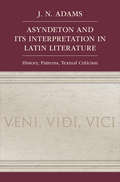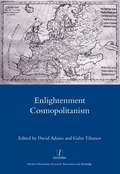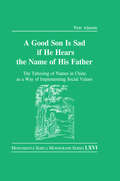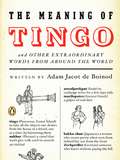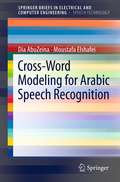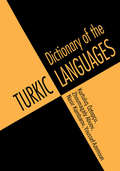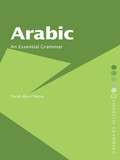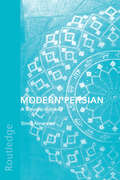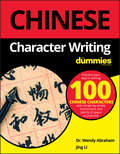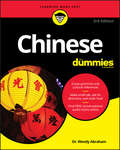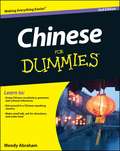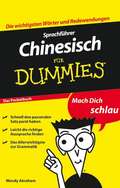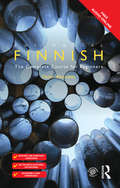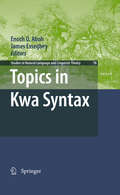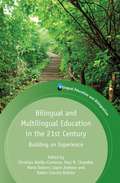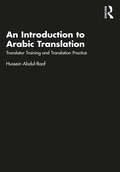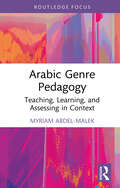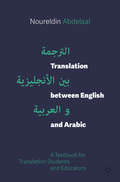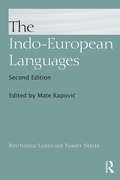- Table View
- List View
Asyndeton and its Interpretation in Latin Literature: History, Patterns, Textual Criticism
by J. N. AdamsAsyndetic coordination (omission of coordinators such as 'but', 'or', 'and') is ancient in Indo-European languages. Most commentaries on Greek and Latin texts index 'asyndeton', but wide-ranging treatments of asyndeton across a variety of literary and non-literary genres are largely lacking, and comments are often impressionistic. This book provides the most comprehensive account of asyndeton in Latin ever attempted, and it also contains material from Greek and Umbrian. It analyses asyndeta in diverse genres from early Latin to the early Empire, including prayers and laws, and aims to identify types, determinants, generic variations and chronological changes. Since coordinators are easily left out or added by scribes, criteria are discussed that might be used by editors in deciding between asyndeton and coordination. External influences on Latin, such as Greek and Italic, are also considered. The book will be essential for all scholars of Latin language and literature as well as historical linguistics.
Social Variation and the Latin Language
by J. N. AdamsLanguages show variations according to the social class of speakers and Latin was no exception, as readers of Petronius are aware. The Romance languages have traditionally been regarded as developing out of a 'language of the common people' (Vulgar Latin), but studies of modern languages demonstrate that linguistic change does not merely come, in the social sense, 'from below'. There is change from above, as prestige usages work their way down the social scale, and change may also occur across the social classes. This book is a history of many of the developments undergone by the Latin language as it changed into Romance, demonstrating the varying social levels at which change was initiated. About thirty topics are dealt with, many of them more systematically than ever before. Discussions often start in the early Republic with Plautus, and the book is as much about the literary language as about informal varieties.
Enlightenment Cosmopolitanism
by David AdamsEnlightenment Cosmopolitanism brings together ten innovative contributions by outstanding scholars working across a wide array of disciplines in the humanities and social sciences. Interdisciplinary in its methodology and compass, with a strong comparative European dimension, the volume examines discourses ranging from literature, historiography, music and opera to anthropology and political philosophy. It makes an original contribution to the study of 18th-century ideas of universal peace, progress and wealth as the foundation of future debates on cosmopolitanism. At the same time, it analyses examples of counter-reaction to these ideas and discusses the relevance of the Enlightenment for subsequent polemics on cosmopolitanism, including 21st-century debates in sociology, politics and legal theory.
Good Son is Sad If He Hears the Name of His Father: The Tabooing of Names in China as a Way of Implementing Social Values (Monumenta Serica Monograph Ser.)
by Piotr AdamekWhen in 1775 the scholar Wang Xihou compiled a dictionary called Ziguan , he wrote, for illustrative purposes, the personal names of Confucius and the three emperors Kangxi, Yongzheng and Qianlong in the introduction. In oversight, he recorded their complete names. This accidental writing of a few names was condemned by Emperor Qianlong as an unprecedented crime, rebellion and high treason. Wang Xihou was executed, his property confiscated and his books were burnt. His family was arrested and his sons and grandsons were killed or sent as slaves to Heilongjiang. It is surprising what an enormous impact the tabooing of names (bihui ) had on Chinese culture. The names of sovereigns, ancestors, officials, teachers, and even friends were all considered taboo, in other words it was prohibited to pronounce them or to record them in writing. In numerous cases characters identical or similar in writing or pronunciation were often avoided as well. The tabooing of names was observed in the family and on the street, in the office and in the emperor's palace. The practice of bihui had serious consequences for the daily lives of the Chinese and for Chinese historiography. People even avoided certain places and things, and refused to accept offices. They were punished and sometimes even killed in connection with the tabooing of names. The bihui custom existed as an important element of Chinese culture and was perceived as significant by Chinese and foreigners alike. It was crucial for implementing social values and demonstrating the political hierarchy. The present work A Good Son Is Sad if He Hears the Name of His Father is a systematic study of Chinese name-tabooing customs, which until now have been relatively little explored in Western-language Sinological studies. It attempts to provide a long-term perspective on the changing dynamics of tabooing and elucidates various aspects related to the fascinating topic of tabooing of names.
The Meaning of Tingo
by Adam Jacot de BoinodDid you know that people in Indonesia have a word that means 'to take off your clothes in order to dance'? Or how many words the Albanians have for eyebrows and moustaches? Or that the Dutch word for skimming stones is plimpplamppletteren? Drawing on the collective wisdom of over 154 languages, this intriguing book is arranged by theme so you can compare attitudes all over the world to such subjects as food, the human body and the battle of the sexes. Here you can find not only those words for which there is no direct counterpart in English (such as the Japanese age-otori which means looking less attractive after a haircut), but also a frank discussion of exactly how many 'Eskimo' terms there are for snow, and a vast array of information exploring the wonderful and often downright strange world of words. Oh, and tingo means 'to take all the objects one desires from the house of a friend, one at a time, by asking to borrow them'.
I Love Saturdays y Domingos
by Alma Flor AdaA girl discuses the differences between her father's American parents and her mother's Mexican parents. Discuses de una muchacha las diferencias entre los padres americanos de su padre y los padres mexicanos de su madre.
Cross-Word Modeling for Arabic Speech Recognition (SpringerBriefs in Speech Technology)
by Dia Abuzeina Moustafa ElshafeiCross-Word Modeling for Arabic Speech Recognition utilizes phonological rules in order to model the cross-word problem, a merging of adjacent words in speech caused by continuous speech, to enhance the performance of continuous speech recognition systems. The author aims to provide an understanding of the cross-word problem and how it can be avoided, specifically focusing on Arabic phonology using an HHM-based classifier.
Dictionary of Turkic Languages
by Zhoumagaly Abuov Nasir Kambarov Youssef AzemounThis multi-language dictionary covers the eight major Turkic languages: Turkish, Azerbaijani, Turkmen, Uzbek, Uighur, Kazakh, Kirgiz, and Tatar. 2000 headwords in English are translated into each of the eight Turkic languages. Words are organized both alphabetically and topically. Original script and Latin transliteration are provided for each language. For ease of use, alphabetical indices are also given for the eight languages. This is an invaluable reference book for both students and learners and for those enaged in international commerce, research, diplomacy and academic and cultural exchange.
Arabic: An Essential Grammar
by Faruk Abu-ChacraArabic: An Essential Grammar is an up-to-date and practical reference guide to the most important aspects of the language. Suitable for beginners, as well as intermediate students, this book offers a strong foundation for learning the fundamental grammar and structure of Arabic. The complexities of the language are set out in short, readable sections, and exercises and examples are provided throughout. The book is ideal for independent learners as well as for classroom study. Features of this book include: coverage of the Arabic script and alphabet a chapter on Arabic handwriting a guide to pronunciation full examples throughout.
Modern Persian: A Course-Book
by Simin AbrahamsModern Persian begins with the teaching of the Persian alphabet. It aims to provide the student with the necessary skills for social interaction, as well as a basis for the study of modern literature. The course consists of seventeen units and favours teaching by communicative and contextual learning. Most units begin with a reading exercise used to introduce an item of grammar and new vocabulary, followed by explanations and drill exercises aimed at consolidating the student's understanding. Complete with Persian-English vocabulary to all the exercises and tape recordings, this is an up-to-date textbook which can be used both by teachers or individuals wishing to learn Persian independently.
Chinese Character Writing For Dummies
by Wendy Abraham Jing LiLearn to write 100 characters in Chinese Billions of people worldwide speak Chinese—and now you can learn to write 100 characters in the world’s most-spoken language! Whether you’re taking a course, looking to get ahead at work, or just want to up the ante when you’re communicating with Chinese-speaking family and friends, Chinese Character Writing For Dummies gets you up to speed fast. This workbook will guide your first steps in learning Chinese characters. It contains 100 basic characters, including 44 simple characters (pictograms and symbols) and 56 composite characters (ideograms and ideo-phonograms). It helps you little by little to familiarize yourself with the pieces of the puzzle most frequently used, as well as some basic Chinese writing rules. Offers online bonus content that includes instructional videos, downloadable flashcards, and printable writing pages Shows you how to write 100 Chinese characters Provides instruction for beginners, students, and lifelong learners Gives you helpful tips on how to memorize characters Speaking Chinese will take you far—and learning to write some of the most common characters will only take you farther! Find out how Chinese Character Writing For Dummies can help you today!
Chinese For Dummies
by Wendy AbrahamThe fun way to learn to speak Chinese With more than 1.2 billion speakers across the globe — and with nearly 3 million in the U.S. alone — Mandarin Chinese claims the top spot as the world’s most common language. If you want to learn this language to get ahead at school or work, or to make your travel to China easier, this is the handy reference you’ll want by your side. Chinese For Dummies teaches basic grammar, as well as the necessary vocabulary to make introductions and greetings, use proper etiquette, make small talk, make transportation arrangements, order food and beverages, ask directions, deal with money, shop, access recreation, and handle an emergency. Concentrates on Mandarin Chinese and features new and revised content Includes major updates to all the necessary foundational information needed to speak Chinese Covers grammar, verb conjugations, and pronunciations Offers a refreshed mini-dictionary complete with even more vocabulary Find free conversational audio tracks online As the Chinese economy continues to grow, the importance of Chinese as a trade language will also increase. If you’re a student or business professional who has a basic understanding of the language, you’ll be poised to surpass your peers when it comes to dealing with international markets. So get started today!
Chinese For Dummies
by Wendy AbrahamThe fast and easy way to learn to speak Mandarin ChineseChina has become a major influence in the world today, and Mandarin Chinese is the world's most widely spoken language. Not only is China full of opportunities in business and politics, but Chinese culture, continues to make its way into the western world. With an updated CD including real-life conversations, Chinese For Dummies expands grammar, verb conjugations, and pronunciations--and includes a refreshed mini-dictionary complete with even more essential vocabulary. Basic vocabularyEveryday conversations, including phone dialogue and small talkSpeaking in perfect pitch and toneEasy-to-understand grammar rulesGetting around in a Chinese-speaking countryCultural references like maintaining face, dining etiquette, and social moresAlso included is an audio CD that features actual Chinese conversations by native Chinese speakers, which allows you to hear how Chinese is really spoken. Written by a leading Chinese language teacher in the United States, Chinese for Dummies introduces an often-daunting language to you in a fun-and-easy For Dummies manner.CD-ROM/DVD and other supplementary materials are not included as part of the e-book file, but are available for download after purchase.
Sprachfuhrer Chinesisch fur Dummies Das Pocketbuch (Für Dummies)
by Wendy Abraham"Sprachführer Chinesisch für Dummies" bietet einen schnellen Überblick über die wichtigsten Wörter und Redewendungen für den Alltag. Jedes Kapitel beschäftigt sich mit einer Alltagssituation: So haben Sie schnell die passenden Sätze parat, wenn Sie beispielsweise im Restaurant bestellen, nach einer Wegbeschreibung fragen oder um Hilfe bitten. Dazu bekommen Sie eine kurze Einführung in die Grammatik und Aussprache des Chinesischen.
Colloquial Finnish: The Complete Course for Beginners (Colloquial Ser.)
by Daniel AbondoloColloquial Finnish provides a step-by-step course in Finnish as it is written and spoken today. Combining a user-friendly approach with a thorough treatment of the language, it equips learners with the essential skills needed to communicate confidently and effectively in Finnish in a broad range of situations. No prior knowledge of the language is required. Key features include: progressive coverage of speaking, listening, reading and writing skills structured, jargon-free explanations of grammar an extensive range of focused and stimulating exercises realistic and entertaining dialogues covering a broad variety of scenarios useful vocabulary lists throughout the text additional resources available at the back of the book, including a full answer key, a grammar summary and bilingual glossaries Balanced, comprehensive and rewarding, Colloquial Finnish will be an indispensable resource both for independent learners and students taking courses in Finnish. Audio material to accompany the course is available to download freely in MP3 format from www.routledge.com/cw/colloquials. Recorded by native speakers, the audio material features the dialogues and texts from the book and will help develop your listening and pronunciation skills.
Topics in Kwa Syntax
by Enoch O. Aboh James EssegbeyThis volume demonstrates that Kwa languages offer a very rich empirical domain for linguistic theorizing, as experts who are mostly native speakers present empirical data and show its theoretical relevance to comparative linguistics and comparative syntax.
Bilingual and Multilingual Education in the 21st Century
by Christian Abello-Contesse Paul M ChandlerBilingual education is one of the fastest growing disciplines within applied linguistics. This book includes the work of 20 specialists working in various educational contexts across Europe, Latin America and North America to create a volume which is both comprehensive in scope and multidimensional in its coverage of current bilingual initiatives. The central themes of this volume, which draws on past experiences of bilingual education, include issues in language use in classrooms at elementary, secondary and tertiary levels; participant perspectives on bilingual education experiences; and the language needs of bi- and multilingual students in monolingual schools. This collection will be of interest to teachers and administrators in bi- and multilingual education programs, as well as scholars working in the field of language education.
An Introduction to Arabic Translation: Translator Training and Translation Practice
by Hussein Abdul-RaofCombining theory and practice, this book is a model for Arabic translation and prepares students for the translation industry. Containing 22 approaches, An Introduction to Arabic Translation provides the normative principles to guide training in Arabic-English-Arabic translation. It revitalizes Arabic-English-Arabic translation through its empirical textual reality, hinged upon Arabic and English authentic contexts and their linguistic, discoursal, and cultural incongruity. The exercises in each chapter provide practical training supported by translation theory. The translation commentaries included represent a critical translation quality assessment based on an analysis of discourse and textual features to highlight the process of translation, the translation approach adopted, and why. Such commentary invites students to reflect on their understanding of the translation process and the approach required for a given Arabic-English-Arabic translation problem. Providing a methodologically comprehensive course of Arabic-English-Arabic translation studies, and insightful discussion of high value for both students and teachers, this book will be invaluable to anyone seeking to learn or improve their Arabic and translation skills.
Arabic Genre Pedagogy: Teaching, Learning, and Assessing in Context (Topics in Arabic Applied Linguistics)
by Myriam Abdel-MalekArabic Genre Pedagogy: Teaching, Learning, and Assessing in Context views Modern Standard Arabic and all spoken varieties of Arabic as one system and offers genre-based instructional resources grounded in systemic functional linguistics (SFL) and genre theory. Divided into three parts, this book explores the Theoretical and Instructional Framework, Spoken Genres, and Written Genres with chapters focusing on everyday social genres including exchanging information, chit-chat, and complaints. This book is aligned with the ACTFL framework and the instructional goals for each genre are articulated in terms of the ACTFL Can-Do Statements. Designed to support instructors of Arabic novice-intermediate learners, the chapters offer step-by-step lessons with practical classroom activities on how to make the language related to each genre explicit to students. Arabic Genre Pedagogy serves as a valuable guide and professional development resource for instructors of Arabic as a world language and for researchers of SFL-informed genre-based approach.
Translation between English and Arabic: A Textbook for Translation Students and Educators
by Noureldin AbdelaalThis textbook provides a comprehensive resource for translation students and educators embarking on the challenge of translating into and out of English and Arabic. Combining a solid basis in translation theory with examples drawn from real texts including the Qu’ran, the author introduces a number of the problems and practical considerations which arise during translation between English and Arabic, equipping readers with the skills to recognise and address these issues in their own work through practical exercises. Among these considerations are grammatical, semantic, lexical and cultural problems, collocations, idioms and fixed expressions. With its coverage of essential topics including culturally-bound terms and differences, both novice and more experienced translators will find this book useful in the development of their translation practice.
Elementary Modern Standard Arabic
by Peter F. AbboudThe Elementary Modern Standard Arabic Course (EMSA) is the premier introduction, for the English-speaking student, to the active written language of the contemporary Arab world. Expressly designed for the beginning student, the course is written by a team of Arabic language teachers consisting of native and non-native Arabic speakers, linguists and people whose primary interests are literature and allied areas. It implements an audio-lingual approach to language teaching while presenting the elements of Modern Standard Arabic as written and spoken in the contemporary Arab World. Volume 1 is complete in itself and presents a practical introduction to the writing system of Arabic and to its pronunciation, with reading and writing pronunciation drills. Thirty lessons provide a basic working knowledge of Arabic. Each lesson contains a text, a vocabulary, grammar and drills including oral and written comprehension passages. An Arabic-English glossary completes the volume. The co
The Indo-European Languages
by Mate Kapovi 263 Anna Giacalone Ramat Paolo RamatThe Indo-European Languages presents a comprehensive survey of the individual languages and language subgroups within this language family. With over four hundred languages and dialects and almost three billion native speakers, the Indo-European language family is the largest of the recognized language groups and includes most of the major current languages of Europe, the Iranian plateau and the Indian subcontinent. Written by an international team of experts, this comprehensive, single-volume tome presents in-depth discussions of the historical development and specialized linguistic features of the Indo-European languages. This unique resource remains the ideal reference for advanced undergraduate and postgraduate students of Indo-European linguistics and languages, but also for more experienced researchers looking for an up-to-date survey of separate Indo-European branches. It will be of interest to researchers and anyone with an interest in historical linguistics, linguistic anthropology and language development.
الألفاظ المختلفة في المعاني المؤتلفة
by محمد بن عبد الملك بن مالك الطائي الجياني أبو عبد اللهكتاب "الألفاظ المختلفة في المعاني المؤتلفة" لابن مالك من كتب علوم اللغة التي تحتوي على العديد من الألفاظ المختلفة المتعددة للكثير من المعاني والكلمات
الانتخاب لكشف الأبيات المشكلة الإعراب
by علي بن عدلان الموصلي النحوييدخل هذا الكتاب في عالم اللغة، حيث عرض فيه المؤلف للأبيات الشعرية المشكلة الإعراب، وحل إشكالها وكشف عن وجوه الإعراب فيها، وقد ضمّ الكتاب 165 بيتاً، واتسم بالاختصار والإيجاز.
اللطائف في اللغة معجم أسماء الأشياء
by أحمد بن مصطفى الدمشقيكتاب "اللطائف في اللغة معجم اسماء الاشياء" لاحمد بن مصطفى الدمشقي يحمل العديد من مرادفات الاسماء و الاشياء المتعددة التي تتميز بها اللغة العربية
